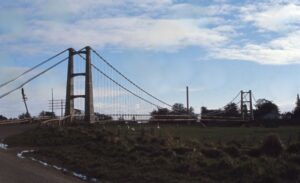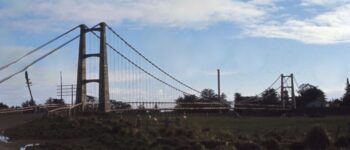1918: Tane Hemp Company Limited Suspension Bridge
September 26, 2023
By AHNZ
 The old Tane Hemp Company Limited Suspension Bridge (aka Opiki Toll Bridge) was taken over by The State. Sure enough, this heritage-listed Manawatu landmark fell into the river last week!
The old Tane Hemp Company Limited Suspension Bridge (aka Opiki Toll Bridge) was taken over by The State. Sure enough, this heritage-listed Manawatu landmark fell into the river last week!
Don’t trust the government with your history and heritage.
Free people in private industry built this bridge during the War and it was opened in January 1918. The bridge opened for public use in the 1920s and served until November 22nd 1969 when the Government finally provided a long-promised bridge.
The Manawatu Catchment Board later took the land and the bridge for “conservation” purposes under the Public Works Act (Government gets to steal your stuff Act) and since then it’s been all down hill.
Private people provided their own infrastructure rather than wait for the Government to ‘save them’ back in these good old days. In its time the bridge didn’t need stolen money to keep it; It paid for its own maintenance by paying users.
“The Ōpiki toll bridge, a 105-year-old monument to the region’s industrial flax-milling history, dropped half of its bundle of wire ropes into the Manawatū River some time around Thursday night.” – Historic Ōpiki bridge falls into the Manawatū River, Stuff (September 2023)
“Heritage NZ Pouhere Taonga central region office acting director Kerryn Pollock said questions about the “ruin” should be directed to its owner, which she said was Horizons. She provided documents that showed land on both sides of the river, including the bridge, had been taken under the Public Works Act for soil conservation and river control purposes, and were vested in the Manawatu Catchment Board, now Horizons.” – ibid
“The privately funded bridge at Opiki was officially opened in January 1918, then known as the Tane Suspension Bridge. The original purpose of the bridge was to transport flax fibre from Tane and Rangitāne Mills to the Rangiotu Railway station, to Palmerston North and then to Foxton for exporting. Many hours and transport costs were thus saved.” – Manawatu Heritage (2022)
“The bridge was opened in January 1918 and was used by the three mills and local farmers. A combination of economic factors and a disease which afflicted flax plants led to the ultimate end of the local industry in 1921.” – Opiki toll bridge: graceful relic of a thriving flax industry, Envirohistory (2011)
“During a visit in 1938, the Minister of Works, Bob Semple, declared that a private toll bridge was unacceptable and that it would be replaced forthwith with a government-built one…The new concrete bridge was completed in November 1969, at which point the old toll bridge was decommissioned.” – ibid
“November 22nd 1969 was a great day of celebration – the opening ceremony for the grand new two-way public bridge, and also the closing ceremony for the toll bridge. The old bridge was decked out with all sorts of flags for the closing ceremony. The locals gave thanks to the owners of the ‘old faithful’ bridge for 44 years of unfailing service. In the 52 years of the bridge’s existance, only one cable had broken.” – Opiki Toll Bridge, Living Heritage (2003)

It’s a great triumph of Free New Zealand that the Libertarian way of building infrastructure worked for the people of Manawatu for over 44 years.
It’s also funny that the ultra-Lefty hot-head Labour 1.0 Minister of Works, Bob Semple, visited this bridge in 1938 to point at it and cry “unacceptable!!!”
You can be fairly sure Semple’s visit was in the lead up to the General Election of that year (15 October, 1938.) Promising New Zealanders bridges that never come is a long-standing method by which politicians become re-elected. In this case it might have back-fired. Labour 1.0 did so well in that election that one of their great rivals, Keith Holyoake, lost his seat. Holyoake reacted by re-locating to the town of his birth and winning the Pahiatua seat in the next election which is just across the way from this Opiki Toll Bridge. Indeed, it might even have been part of his electorate. It was Holyoake that helped put an end to the Labour 1.0 Government as well as the Labour 2.0 to follow.
And, finally, it was on ‘Kiwi Keith’s’ watch that a new bridge did finally come along to replace this historic one. The new bridge opened on 22 November, 1969, to much fanfare. The General Election of 1969 occurred just 7 days later: 29 November. Interesting timing, that. Do you believe in accidents when it comes to politics and political promises?
—
Image ref. Terry Finnerty (c.1960,) manawatuheritage.pncc.govt.nz; Some dust specs removed (hastily) by AHNZ (2023)
2 thoughts on "1918: Tane Hemp Company Limited Suspension Bridge"
Leave a Reply
 Like Comment Share
Like Comment Share






The misappropriated public confiscation act has always riled me as I was taught at school that simply said that land taken by Govt would be offered back to owner if not used for the taken purpose. An example is the Waterview straight, houses demolished for mway/ road widening now have high rises on the south end sections.This land should have been offered back to the origonal owners who could have made a profit to compensate for being forced to sell to the state.
Crooks every time. In this case there was some idea that the river level would rise due to stop banks and the bridge submerged; Appears not to have eventuated at all.